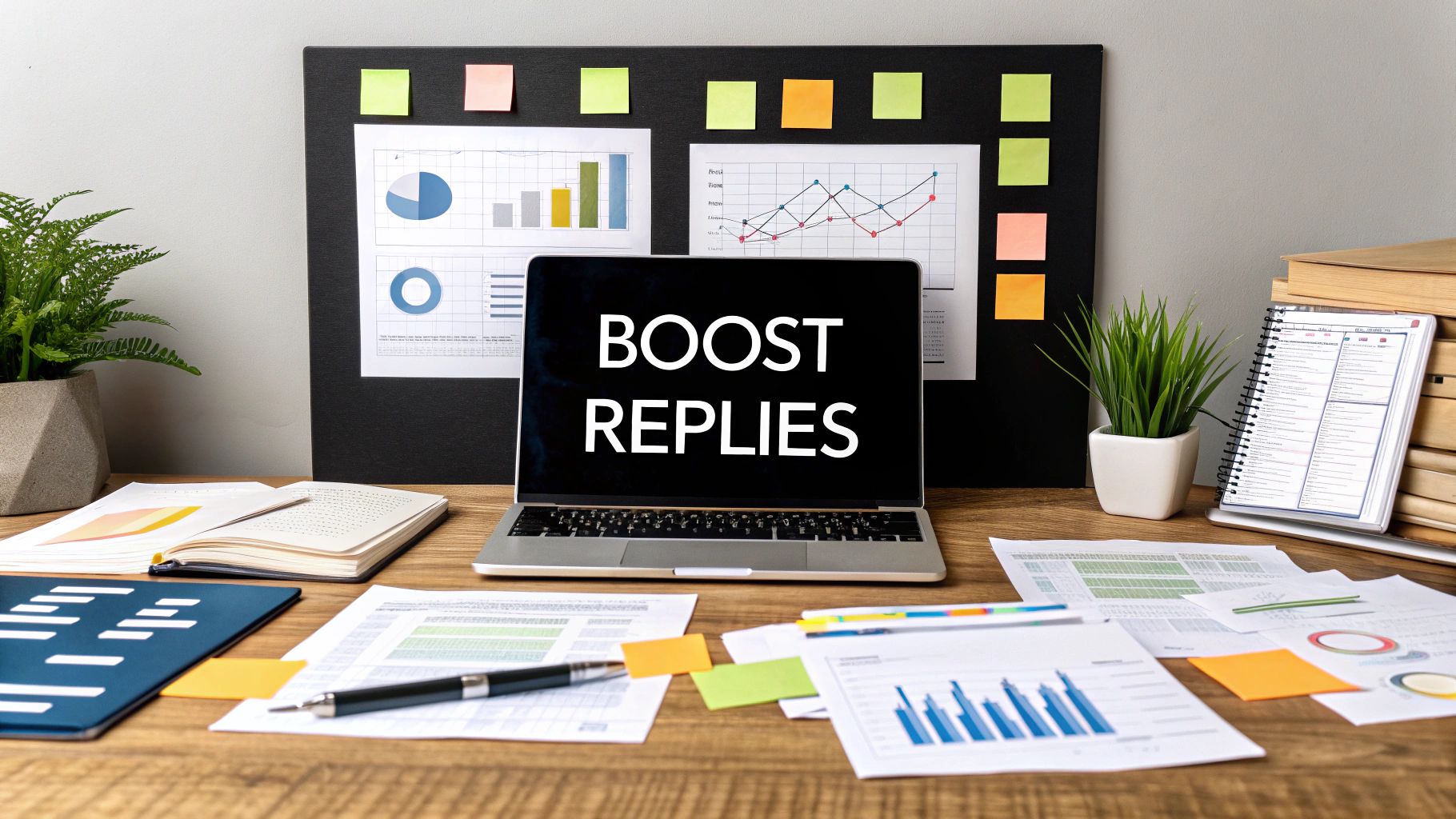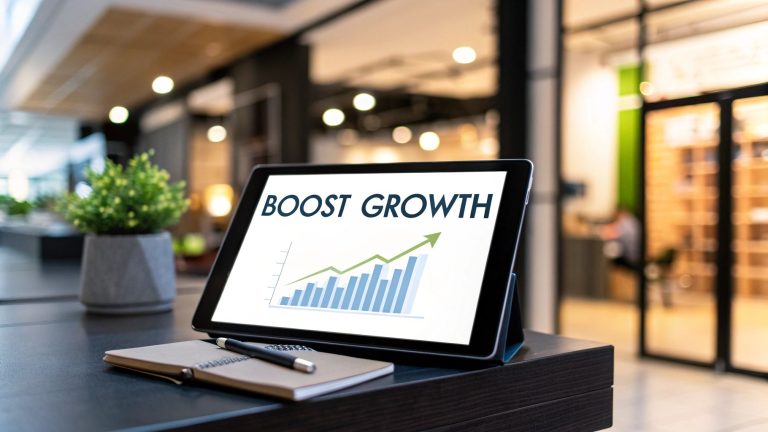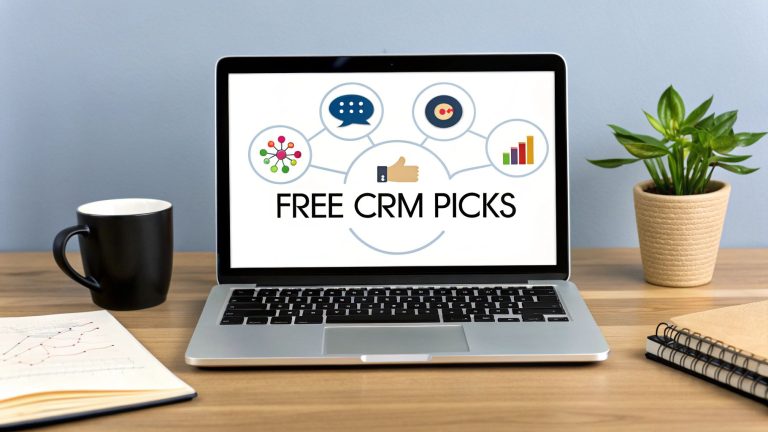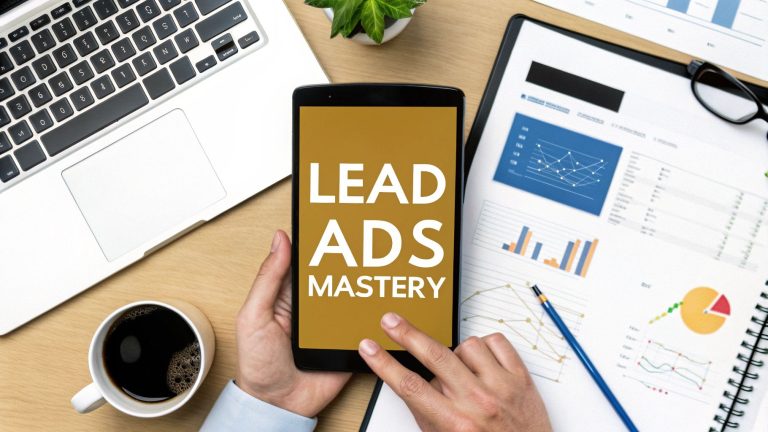7 Sales Email Follow Up Examples to Boost Replies in 2025
Stop Ignoring Your Unopened Emails: Follow-Up Strategies That Actually Work
Did you know 80% of sales require five follow-up emails? Most salespeople give up after one or two. Mastering the follow-up is crucial for converting leads. This article provides seven powerful sales email follow-up examples to transform your sales process and boost your reply rate. We'll explore diverse strategies including the Value-Add, Social Proof, and Multi-Channel approaches.
Each example includes a deep dive into why it works, plus actionable takeaways you can implement immediately. Learn how to craft compelling follow-ups like:
- The Value-Add Follow-Up
- The Social Proof Follow-Up
- The Breakup Email
- The Question-Based Follow-Up
- The Referral Follow-Up
- The Timely/Trigger Event Follow-Up
- The Multi-Channel Follow-Up
Stop letting potential deals slip away. Learn to turn unopened emails into closed deals by mastering these sales email follow up examples. Let's dive in.
1. The Value-Add Follow-Up
The Value-Add Follow-Up shifts the focus from a direct sales ask to providing genuine value to your prospect. Instead of simply checking in, you offer helpful resources like relevant content, insightful data, or tools tailored to their specific pain points. This positions you as a trusted advisor, not just another salesperson. It's about building a relationship based on mutual benefit.
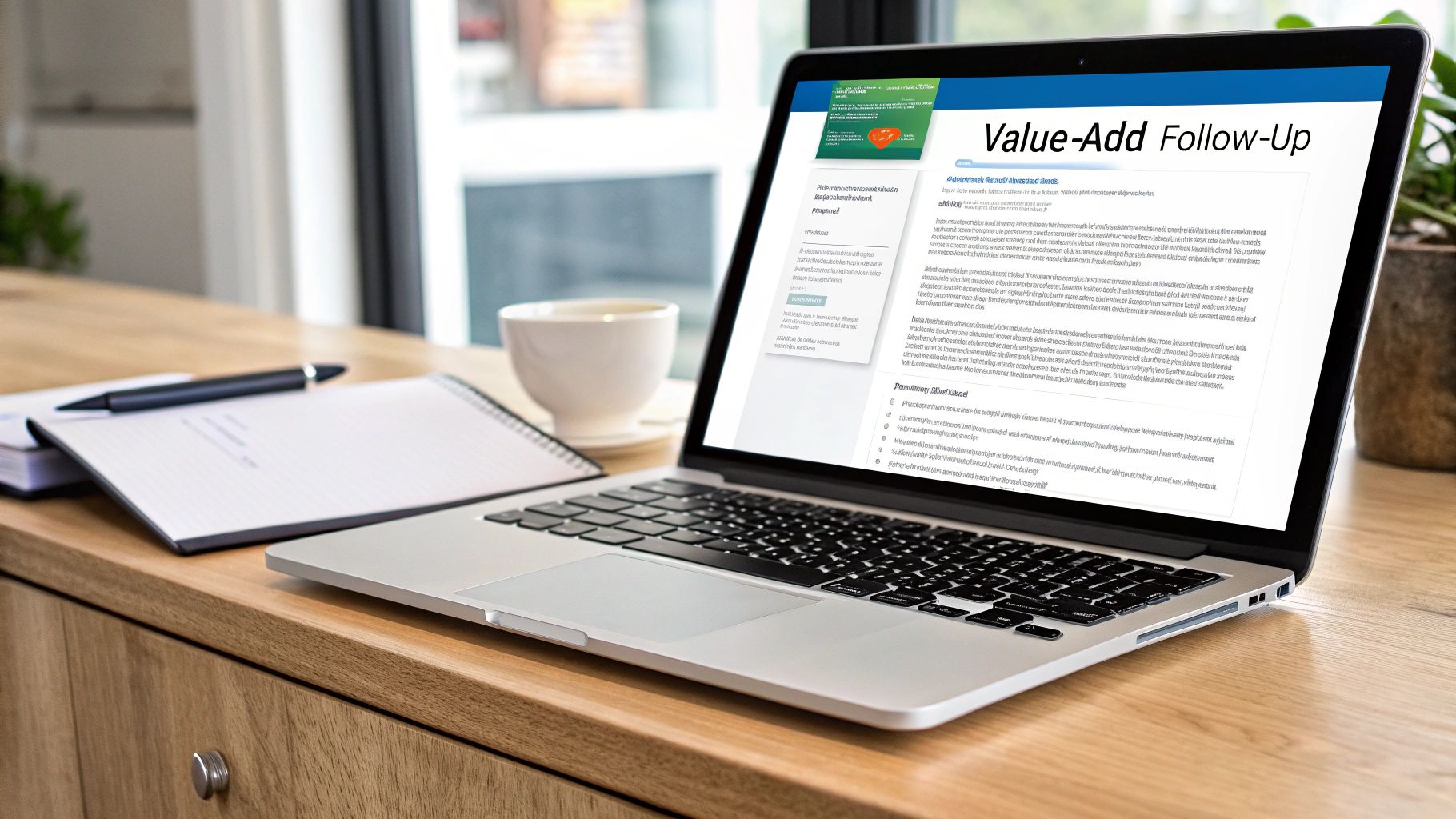
Examples of Value-Add Follow-Ups
- HubSpot: Provides free marketing templates that directly address lead generation challenges, a common pain point for many businesses.
- Salesforce: Shares industry-specific ROI reports demonstrating the value of their CRM platform and addressing financial concerns.
- LinkedIn Sales Navigator: Offers guides on social selling techniques, empowering prospects with actionable strategies to improve their outreach.
These sales email follow up examples demonstrate how value-added content can be incorporated into a follow-up strategy. By offering resources tailored to prospect needs, these companies nurture leads effectively. For example, providing a marketing template in a follow-up email not only offers value but also subtly showcases the company's expertise. This builds trust and positions them as a knowledgeable partner. Learn more about…
Actionable Tips for Implementing Value-Add Follow-Ups
- Research: Dive deep into the prospect's company news, industry trends, and recent challenges. Understanding their context is key to providing relevant value.
- Curate: Don't just send anything – carefully select content that directly addresses their specific situation. The more tailored the content, the greater the impact.
- Prioritize Value: Lead with the valuable content. Make it the primary focus of your email. The sales ask, if any, should be secondary.
- Consultative Tone: Adopt a helpful, consultative tone. Your goal is to be a resource, not a pusher.
When and Why to Use Value-Add Follow-Ups
This strategy is particularly effective in longer sales cycles or when dealing with high-value prospects. It's ideal for situations where building trust and demonstrating expertise is crucial. Value-add follow-ups nurture leads by demonstrating genuine interest in their success.
This approach allows you to stay top-of-mind without being overly aggressive. By consistently providing valuable insights, you position yourself as a go-to resource, increasing the likelihood of conversion when the prospect is ready to buy. It's a smart, strategic approach to nurturing leads and building lasting relationships.
2. The Social Proof Follow-Up
The Social Proof Follow-Up leverages the persuasive power of "seeing others do it." This approach uses testimonials, case studies, and success stories to build credibility and overcome objections. It capitalizes on the psychological principle that people are more likely to convert when they see similar businesses achieving positive results with the same product or service. This tactic subtly reassures prospects that they're making a smart, low-risk decision.
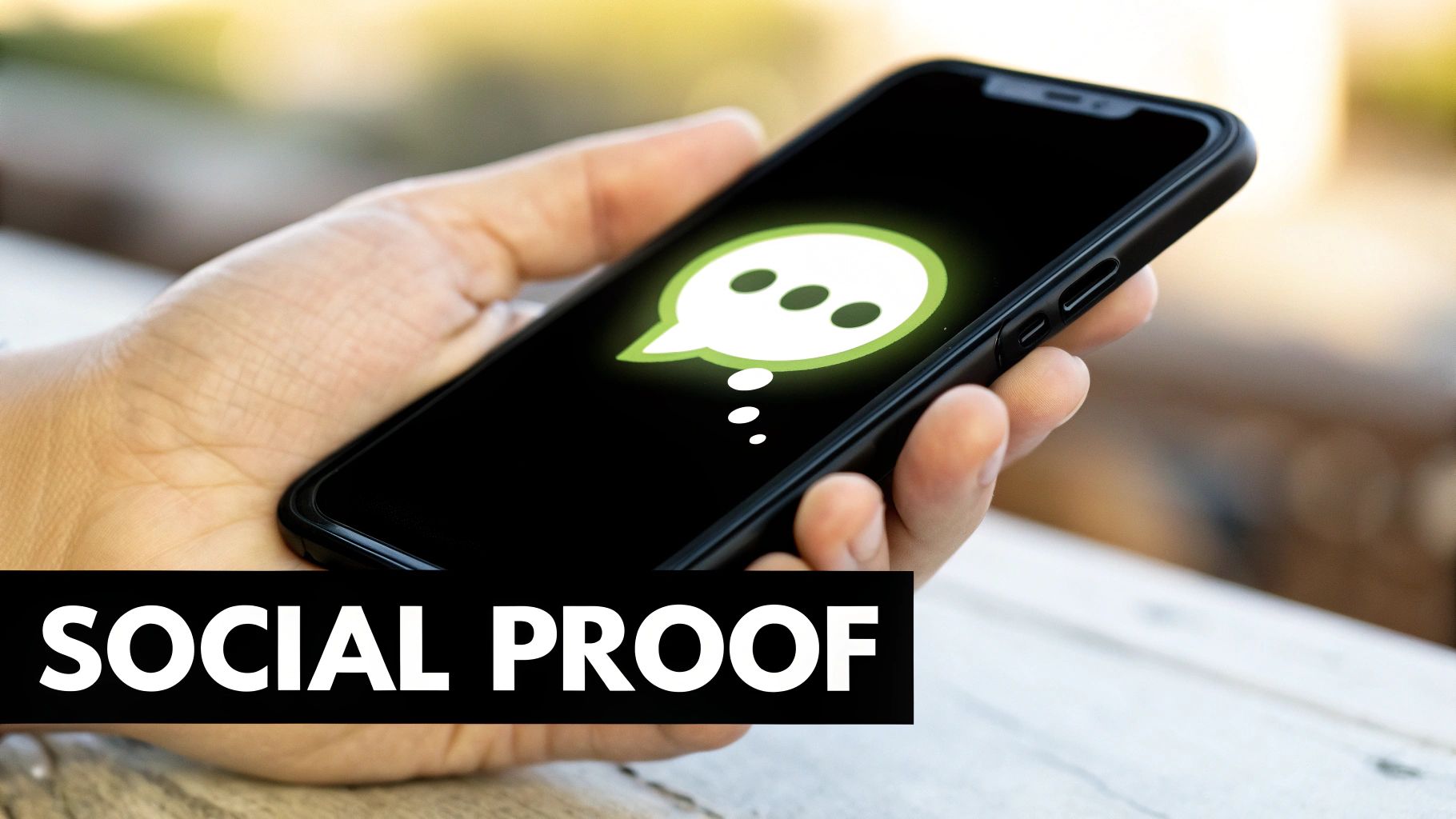
Examples of Social Proof Follow-Ups
- Slack: Shares data on how companies like theirs increased productivity by 25% after implementing their communication platform. This quantifiable result resonates with prospects looking for tangible benefits.
- Zoom: Highlights success stories from Fortune 500 clients, demonstrating their platform's reliability and scalability for enterprise-level businesses. This builds trust and credibility.
- Shopify: Showcases e-commerce growth metrics from similar retailers, illustrating the potential for increased sales and revenue. This appeals directly to a core desire of online businesses.
These sales email follow up examples demonstrate how social proof can be incorporated effectively. By showcasing successful implementations, these companies create a sense of confidence and reduce purchase anxiety. For example, sharing specific productivity gains achieved by other companies using Slack provides concrete evidence of its value proposition.
Actionable Tips for Implementing Social Proof Follow-Ups
- Relevance: Match social proof to the prospect's company size, industry, and specific challenges. The more relatable the example, the greater the impact.
- Quantify: Include specific numbers and percentages whenever possible. Quantifiable results are more persuasive than general claims.
- Recency: Use recent success stories for maximum relevance and impact. Outdated examples can lose their persuasive power.
- Variety: Combine multiple forms of social proof, such as testimonials, case studies, and data-driven results, for a more comprehensive approach.
When and Why to Use Social Proof Follow-Ups
This strategy is particularly effective when dealing with prospects who are hesitant or skeptical. It's also useful in competitive markets where differentiation is crucial. Social proof provides the reassurance needed to move prospects closer to a purchasing decision.
By demonstrating that others have successfully used your product or service, you reduce perceived risk and build trust. This subtle yet powerful approach can be the tipping point in converting prospects into paying customers. It reinforces the value proposition and provides tangible evidence of your claims.
3. The Breakup Email
The Breakup Email is a counterintuitive yet powerful sales email follow-up strategy. It leverages reverse psychology by politely informing the prospect that you'll stop contacting them. This seemingly final message often creates a sense of urgency and prompts a response from those who have been consistently unresponsive. It removes the pressure of constant follow-ups, subtly suggesting scarcity and the potential loss of a valuable resource.

Examples of Successful Breakup Emails
- Outreach.io: Their well-known breakup email template boasts a remarkable 33% response rate, demonstrating the effectiveness of this strategy.
- Close.com: Their "Should I stay or should I go?" email series uses a similar approach, prompting prospects to clarify their interest level.
- Lemlist: Uses breakup email campaigns tailored for SaaS prospects, addressing their specific pain points and offering one last chance to engage.
These sales email follow up examples highlight how a breakup email can re-engage unresponsive prospects. By respectfully withdrawing, these companies often trigger a response, allowing them to qualify the lead or re-initiate a conversation. The key is the subtle shift in dynamic from pursuer to pursued.
Actionable Tips for Implementing Breakup Emails
- Timing: Send a breakup email after 4-6 previous attempts with no response. This shows persistence before respectfully disengaging.
- Tone: Maintain a friendly and professional tone. Avoid sounding accusatory or resentful. Focus on understanding their needs.
- Re-engagement: Include an easy way for the prospect to re-engage, such as a clear call to action or a simple "reply to this email" instruction.
- High-Value Prospects: Don't actually break up with high-value prospects. Consider alternative follow-up strategies instead.
When and Why to Use Breakup Emails
Breakup emails are best used in situations where a prospect has gone cold after multiple follow-ups. It's an effective strategy for recapturing their attention and qualifying leads. This method is particularly useful for sales teams dealing with high volumes of leads, allowing them to efficiently filter out unresponsive prospects.
This approach allows sales teams to focus their energy on engaged leads while still offering a final opportunity for unresponsive prospects to connect. It can be a valuable tool for uncovering hidden opportunities and maximizing sales efficiency. This strategy offers a unique way to break through the noise and reignite a conversation.
4. The Question-Based Follow-Up
The Question-Based Follow-Up pivots away from direct promotion and instead engages prospects with thought-provoking questions. This approach encourages a dialogue, fostering a two-way conversation rather than a one-way sales pitch. It focuses on understanding the prospect's unique situation and specific challenges through strategic questioning. This naturally steers the conversation towards relevant solutions and sales discussions.
Examples of Question-Based Follow-Ups
- Focusing on Challenges: "How is your team currently handling the increasing demands of data compliance?"
- Identifying Obstacles: "What's the biggest obstacle preventing your company from achieving its projected growth targets this year?"
- Uncovering Priorities: "If you could wave a magic wand and solve one problem this quarter, what would it be?"
These sales email follow up examples illustrate how strategic questions can re-engage prospects. By asking insightful questions, you demonstrate genuine interest in their needs and position yourself as a problem-solver. For example, asking about their biggest obstacle shows that you're not just trying to sell something, but are genuinely invested in their success. This builds trust and opens the door for a more meaningful conversation.
Actionable Tips for Implementing Question-Based Follow-Ups
- Research First: Thoroughly research the prospect's industry and common challenges before crafting your questions. The more relevant your questions, the more likely you are to receive a thoughtful response.
- Genuine Curiosity: Ask questions you genuinely want answered. Authenticity shines through, and prospects can sense when you're genuinely interested in their perspective.
- Follow-Up Questions: Don't just ask a question and leave it hanging. Be prepared to follow up on any responses with deeper, more probing questions. This demonstrates your commitment to understanding their needs.
- Open-Ended Questions: Avoid simple yes/no questions. Aim for open-ended questions that encourage detailed responses and provide valuable insights into their situation.
When and Why to Use Question-Based Follow-Ups
This tactic is particularly effective when initial outreach hasn't generated a response or when dealing with prospects who are hesitant to engage. It's ideal for rekindling conversations and uncovering hidden pain points. Question-based follow-ups allow you to gather valuable information and tailor your subsequent communication to their specific needs.
This approach can be highly effective because it shifts the focus from your product to the prospect's challenges. By actively listening to their responses and engaging in a genuine dialogue, you can build rapport, establish credibility, and position yourself as a trusted advisor. This creates a more receptive environment for discussing how your solution can address their specific needs.
5. The Referral Follow-Up
The Referral Follow-Up leverages the power of warm introductions. By mentioning a shared contact, mutual connection, or referral source, you instantly build credibility and trust with your prospect. This approach establishes common ground and significantly increases the likelihood of a response compared to cold outreach. It capitalizes on existing relationships to create a more receptive audience.
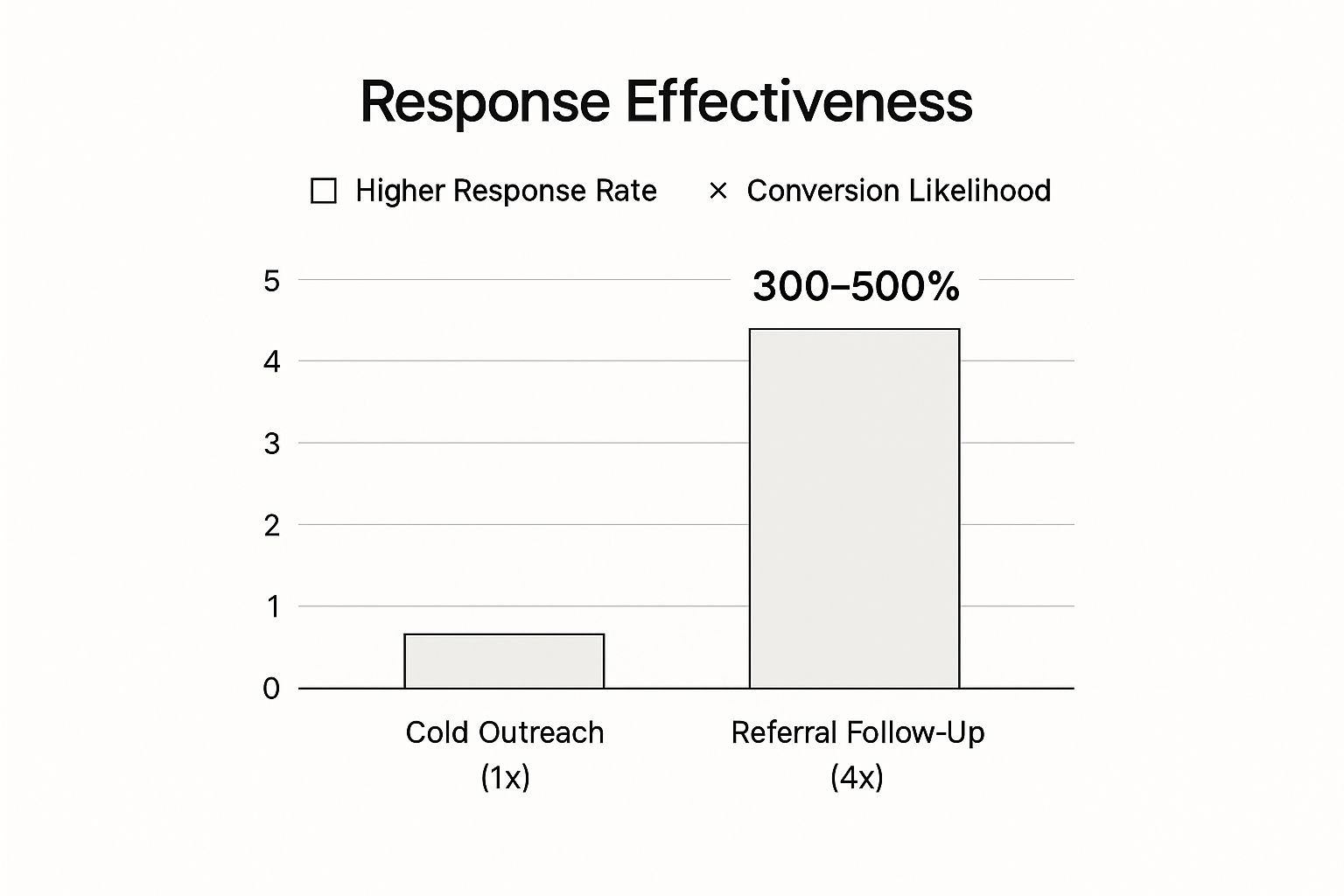
The bar chart above compares the response effectiveness of cold outreach versus referral follow-up. As the chart clearly shows, leveraging referrals dramatically increases your chances of success. Referral follow-ups generate a response rate up to 4 times higher than cold outreach, leading to a significantly greater conversion likelihood.
Examples of Referral Follow-Ups
- Referral from a colleague: "John Smith at ABC Corp suggested I reach out regarding your upcoming expansion."
- Referral from a mutual connection: "Sarah mentioned you might be interested in our new platform during the conference."
- Referral from a satisfied customer: "Following up on Tom's recommendation about your team's current challenges." These sales email follow up examples highlight how a brief mention of the referring party instantly adds weight and relevance to the message.
Actionable Tips for Implementing Referral Follow-Ups
- Always Get Permission: Before using someone's name, ensure you have their explicit consent to make the referral. This protects your relationships and avoids awkward situations.
- Explain the Connection Context: Briefly explain how you know the referring party and why they thought you should connect. This adds clarity and legitimacy to your message.
- Don't Oversell the Referral: Focus on the value you bring and how you can help the prospect. Avoid overstating the referral relationship.
- Follow Up with the Referrer: Keep the referring party informed about the outcome of your outreach. This demonstrates professionalism and strengthens your relationship.
When and Why to Use Referral Follow-Ups
Referral follow-ups are ideal when you have a direct connection to the prospect through a mutual contact. This tactic is particularly effective in early-stage outreach or when trying to engage with high-value prospects. It works because it immediately breaks down barriers and fosters trust, allowing you to skip the cold introduction.
This strategy is also a valuable tool for building stronger relationships with existing clients. By asking for referrals, you encourage clients to become advocates for your business. This generates warm leads and positions you for continued success. Leveraging referrals is a smart strategy for any sales professional seeking to maximize their impact and accelerate their sales cycle.
6. The Timely/Trigger Event Follow-Up
The Timely/Trigger Event Follow-Up capitalizes on recent company news, events, or changes that create natural opportunities for outreach. This method demonstrates awareness of the prospect's business situation and provides relevant context for why the timing might be perfect for your solution. It's about striking while the iron is hot, leveraging current events to make your outreach more relevant and timely.
Examples of Timely/Trigger Event Follow-Ups
- Funding Announcement: "Congratulations on your recent Series B funding – expansion must be exciting! I understand scaling operations can be a challenge, and our solution can help streamline…"
- Acquisition: "I saw your company just acquired XYZ Corp – how are you handling the integration? We've helped numerous companies navigate post-acquisition transitions, and we'd love to share our expertise."
- Product Launch: "With your new product launch, you're probably seeing increased customer service demands. Our platform can automate key support functions, allowing you to scale efficiently."
These sales email follow up examples demonstrate how staying informed about prospect companies can create highly relevant outreach opportunities. By connecting your solution to a recent event, you demonstrate genuine interest and offer value at a crucial moment. For instance, acknowledging a funding round and then positioning your product as a solution for growth challenges shows you understand their current priorities.
Actionable Tips for Implementing Timely/Trigger Event Follow-Ups
- Set Up Alerts: Use Google Alerts, LinkedIn newsfeeds, and industry publications to monitor prospect companies and stay informed about relevant events.
- Monitor Social Media: Keep an eye on LinkedIn and other social platforms for announcements, news, and changes within the prospect's company.
- Connect the Event to a Need: Clearly articulate how your solution directly addresses a challenge or opportunity presented by the trigger event.
- Act Quickly: Time is of the essence. Reach out while the news is still fresh and top-of-mind for the prospect.
When and Why to Use Timely/Trigger Event Follow-Ups
This strategy is highly effective when you can directly tie a trigger event to a business need your solution addresses. It's ideal for situations where demonstrating real-time awareness and relevance can significantly impact the prospect's decision-making process. Timely follow-ups allow you to position your solution as a timely intervention, rather than an interruption.
By capitalizing on relevant events, you demonstrate that you're not just sending generic emails but are truly invested in the prospect's success. This approach fosters trust and positions you as a proactive partner. Learn more about… This allows you to cut through the noise and connect with prospects in a meaningful way, increasing the likelihood of engagement and conversion. It's a smart strategy for staying top-of-mind and capitalizing on opportune moments.
7. The Multi-Channel Follow-Up
The Multi-Channel Follow-Up recognizes that prospects engage with content across various platforms. This strategy leverages this behavior by coordinating follow-up efforts across email, phone, LinkedIn, and even social media. By strategically varying your touchpoints, you dramatically increase your chances of connecting with a prospect on their preferred channel. This creates a more personalized and persistent outreach experience. This approach helps you cut through the noise and fosters stronger connections.
Examples of Multi-Channel Follow-Ups
- Email & LinkedIn: Send a follow-up email, then a LinkedIn connection request with a personalized message referencing the email. This combines the formality of email with the personal touch of LinkedIn.
- Voicemail & Recap: Leave a voicemail, then immediately send a follow-up email summarizing the voicemail and offering to reschedule. This reinforces your message and provides a written record.
- Video Email & Social: Send a personalized video email, then engage with the prospect's recent social media posts. This adds a human element while demonstrating genuine interest.
These sales email follow up examples showcase how multiple channels can create a cohesive outreach experience. By connecting through various platforms, you demonstrate persistent, but not pushy, follow-up. For instance, combining a video email with social engagement creates a memorable and personalized interaction. This builds rapport and increases the likelihood of a response.
Actionable Tips for Implementing Multi-Channel Follow-Ups
- Consistent Messaging: Maintain a consistent message across all channels, reinforcing your key points.
- Strategic Spacing: Don't bombard your prospect. Space out touchpoints appropriately to avoid seeming overly aggressive.
- Reference Previous Interactions: Acknowledge previous communications in each follow-up ("As mentioned in my voicemail…"). This shows attentiveness.
- Track Preferred Channels: Note how the prospect responds. This provides valuable insight into their communication preferences.
When and Why to Use Multi-Channel Follow-Ups
Multi-channel follow-up is particularly effective when dealing with unresponsive prospects or in competitive sales environments. It's ideal for high-value prospects or complex sales where building a strong relationship is critical. This strategy is also beneficial for those seeking to automate their lead communication via various integrations, as detailed further here: Learn more about…. By strategically utilizing multiple touchpoints, you increase visibility and stay top-of-mind, maximizing your chances of converting leads into customers. It's a dynamic and highly effective approach to modern sales engagement.
7 Sales Email Follow-Up Types Compared
| Follow-Up Type | Implementation Complexity 🔄 | Resource Requirements ⚡ | Expected Outcomes 📊 | Ideal Use Cases 💡 | Key Advantages ⭐ |
|---|---|---|---|---|---|
| The Value-Add Follow-Up | Moderate – requires content curation and research | Medium – access to quality content/tools | Builds trust, nurtures long-term relations | When educating prospects, building credibility | Positions as advisor, higher engagement |
| The Social Proof Follow-Up | Moderate – gathering testimonials and metrics | Medium – client permissions and assets | Increases credibility, reduces risk | Overcoming objections with proof, trust-building | Concrete proof, creates FOMO |
| The Breakup Email | Low – straightforward final message | Low – simple template | Often highest response rates, clears leads | Re-engaging unresponsive prospects, pipeline cleanup | Creates urgency, saves time |
| The Question-Based Follow-Up | Moderate – needs skilled questioning | Low-Medium – knowledge and prep | Encourages dialogue, uncovers needs | Complex sales needing discovery conversations | Positions as consultant, higher engagement |
| The Referral Follow-Up | Low-Moderate – dependent on network and permissions | Low – requires referrer cooperation | Dramatically higher response and conversion | Warm introductions, leveraging mutual connections | Builds instant trust, shortens sales cycle |
| The Timely/Trigger Event Follow-Up | Moderate – needs constant monitoring | Medium – research tools and alerts | Highly relevant, increases response rates | Capitalizing on recent news or events | Shows awareness, natural conversation starter |
| The Multi-Channel Follow-Up | High – managing multiple channels/coordination | High – platforms, tools, coordination | Higher total response and connect rates | Complex outreach requiring varied contact approaches | Maximizes visibility, accommodates preferences |
From Follow-Up to Close: Turn Emails into Revenue
Throughout this article, we've explored seven powerful sales email follow-up examples, dissecting the strategies behind their success. From the value-add approach to leveraging social proof and even the "breakup" email, each example provides actionable insights you can implement immediately. These sales email follow up examples demonstrate that effective follow-up is about more than just persistence; it's about providing genuine value and building a connection with your prospect.
Key Takeaways for Effective Follow-Ups
-
Personalization is Paramount: Generic follow-ups often fall flat. Tailor your message to the individual and their specific context. Reference previous conversations, their company's challenges, or relevant industry trends.
-
Value-Driven Communication: Don't just ask for the sale. Offer valuable resources, insights, or solutions that address the prospect's needs. This positions you as a helpful advisor, not just a salesperson.
-
Strategic Timing: The timing of your follow-up is crucial. Consider the prospect's buying cycle and use trigger events, such as website visits or content downloads, to send timely and relevant messages.
-
Multi-Channel Approach: Don't limit yourself to email. Integrate other channels like LinkedIn or phone calls to create a more comprehensive and engaging follow-up experience. This increases your touchpoints and strengthens your connection with the prospect.
Why Mastering Follow-Up is Essential
Mastering the art of the sales email follow-up is a game-changer for your revenue generation. It allows you to:
- Reconnect with Lost Leads: Re-engage prospects who initially showed interest but went cold.
- Build Stronger Relationships: Nurture leads by providing consistent value and building trust.
- Increase Conversion Rates: Improve your chances of closing deals by staying top-of-mind and addressing prospect concerns.
- Shorten Sales Cycles: Move prospects through the pipeline more efficiently by providing timely and relevant information.
By implementing the strategies outlined in these sales email follow up examples, you'll be well on your way to transforming your follow-up process from a routine task into a powerful revenue-generating engine. Don't just send follow-ups; send smart follow-ups that resonate with your prospects and drive results.
Ready to streamline your sales email follow-up process and turn more leads into customers? LeadSavvy Pro helps you automate lead capture, manage follow-up sequences, and track your progress, freeing up your time to focus on building relationships and closing deals. Visit LeadSavvy Pro today and transform your follow-up game.

